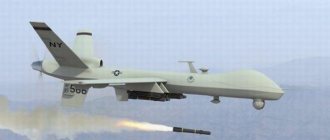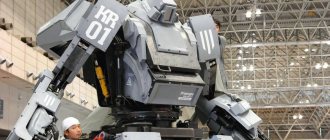Who would have thought ten years ago that the Russian army would become a trendsetter in terms of combat equipment. But in 2014 the whole world saw the uniform of “polite people”. And then - more. First "Ratnik-2", then prototypes of 3rd generation equipment. It was immediately dubbed the equipment of the “soldier of the future.” And she is ready to join the Russian army today. What is this “armored shell” with advanced electronic filling of a 21st century fighter? Army Standard studied the issue.
The characteristics of Russian army combat equipment bring to mind science fiction. Take the same exoskeleton. Weighing some 8 kilos, it helps a fighter to easily shoulder all 50 kg, making them a barely noticeable burden for a soldier on a forced march.
What about body armor with ceramic-composite panels? It protects against bullets and shrapnel, and is not afraid of being shot at point-blank range. And even a hit from an armor-piercing incendiary cartridge will not cause visible damage to a Russian soldier.
The head, joints, spine - everything is protected by “smart” technologies. No cases of penetration have been recorded in four years, and yet the “Ratnik” has been tested in combat in Syrian operations! The Arctic version of the special suit did not disappoint either. A battery charge of four hours ensured comfort for testers in 40-degree frost in the Arctic. The suits did not cause any complaints in harsh conditions.
© rostec.ru
With a drone and a machine gun at the ready
While foreign military experts were discussing the miracle of Russian technical thought, the next version of Russian combat equipment appeared on the foreground. And also with an exoskeleton. This time active and with a machine gun at the ready. It was demonstrated last year by the Klimov TsNIITochmash.
A multi-layer body armor made of cellular composites, massive elbow pads, covered with an armored helmet, reminiscent of the headdresses of Formula 1 pilots - this is how the new product appeared on the day of the demonstration. The specialists were especially amazed by the video recording, which showed sniper shooting from a heavy machine gun mounted “on the arm” of an exoskeleton. A short burst - and all the bullets hit the bull's eye.
Our engineers reasonably kept silent about the technical details of the active exoskeleton sample. However, experts were able to recognize some details: a lightweight and durable structure made of titanium alloy and composites, as well as components of the “smart” filling of a closed helmet.
Equipment with an active exoskeleton is a real technological breakthrough. Multilayer cellular armor made of titanium protects against bullets and shrapnel at 360 degrees. The lever-articulated design made of lightweight carbon fiber helps not only to run and jump over obstacles
I, but also conduct automatic fire at specified targets.
The machine gun arm places bullets in the center of the target with minimal spread. The new Ratnik is equipped with a bullet-resistant glass monitor, on the screen of which “friend or foe” markers are displayed, an electronic sight with a laser rangefinder, a thermal imager and a video camera.
Separately, it is worth mentioning the Sagittarius intelligence, control and communications complex. A computer with peripherals distributed throughout the unloading area ensures communication between unit soldiers at a distance of up to one and a half kilometers. The laser rangefinder of the commander's tablet determines the exact coordinates of targets. Automatically dropped into the headquarters computer, they will instantly adjust artillery fire and air support.
© rostec.ru
A special “trick” is the visor. From the inside, it is a real 3D screen, broadcasting a picture of the world in real time. An eye movement and a mini-drone takes off into the air, showing the battlefield from above and providing a tactical advantage. In the future - a group of attack drones, rising into the air at the command of a fighter and raining firepower on the enemy hiding in front. All this will very likely be included in the equipment of the new “Ratnik” in the near future.
Russia, together with the new “Warrior,” is becoming a leader in creating the concept of the “warrior of the future.” And this is especially surprising, because back in 2011 we seemed to be hopelessly behind our competitors. All that a Russian fighter could afford at that time was a hodgepodge of different sets of equipment, sometimes no longer corresponding to the time and moment. And at this time, on the other side of the Atlantic, the “soldier of the 21st century” was already being created. Their engineers did not hesitate to translate into reality fantastic ideas that originated in the 60s of the last century.
Electronic protection in the US Army
The electronic equipment of the American army and special forces was considered one of the best in the world. This segment of the armor of the future includes panoramic night-time devices GPNVG-18, one set of which costs about 40 thousand dollars. US military developers continue to pay close attention to improving devices for surveillance and combat missions at night or in low visibility conditions.
The American army is going to introduce another special gadget. These are augmented reality glasses called HUD-3. They are equipped with a microscopic computer with a scanner that allows you to display the necessary information directly before the fighter’s eyes. So far, the idea has not been implemented in practice, but the importance of such an idea for protecting combat equipment is recognized and supported by dozens of countries.
Exoskeleton named after the warrior god
The first US exoskeleton, named Hardiman, was assembled in General Electric laboratories in 1967. It was conceived for airfield service of military aircraft. Mechanical arms attached 1,000-pound bombs under the wings much faster than conventional technicians with carts. The bomber's maintenance time could be halved - from 60 minutes to half an hour.
But after four years all work was stopped. The cyborg of the rock and roll era had too many shortcomings. This includes a weight of more than three tons, clumsiness, and unstable balance, but most importantly, low precision of manipulation: Hardiman could easily drop a bomb at his feet. The prospect of turning the hangars into smoking craters scared the Pentagon, and the project was closed until better times.
The idea of terminators was returned to in the 21st century. New materials and new technologies have made it possible to talk about it as something real. And in 2010, American designers showed the world XOS-2 - a robotic suit for the US Army. The exoskeleton allowed the fighter to take 17 times his own weight, but it turned out to be unaffordable at the price: 150 thousand dollars per set. While Raytheon was looking for ways to make the product cheaper, competitors came to the rescue. An entire alliance of developers, including such giants as Boeing, Lockheed Martin, with the support of leading technical universities, presented the TALOS (Tactical Assault Light Operator Suit) robotic suit in May 2013.
Named after the warrior god from the popular video game, Talos transforms a fighter into a superhero. Built-in servos give the wearer superhuman strength, integrated control systems monitor the temperature inside the suit; pulse, pressure and cardiac activity of a fighter, and in a critical situation they will provide first aid by injecting a cocktail of medications into a vein. Smart electronic “brains” also provide communications and navigation on the battlefield.
The metal-composite alloy body is fitted with the precision of the famous Milanese armor of the late Middle Ages. Modular units made of Kevlar materials form a one-piece design that does not restrict movement and provides full ballistic protection. According to manufacturers, 60% of the body surface, including all vital organs. In the near future, TALOS may acquire unique protection made of “liquid” ceramics. It was developed by Professor Norman Wagner from the University of Delaware. The moment the exoskeleton is hit, the liquid material will instantly become covered with a hard shell, blocking the damage.
© rostec.ru
Equipped with Talos, American soldiers were supposed to turn into invincible warriors. But the rapid breakthrough of the Russian defense industry negated the emerging advantage. We caught up with our competitors in several directions at once. But most of all in the struggle for the “warrior of the future” the Americans were stung by our “chameleon camouflage”.
Electronic gadgets
Just a few years ago, electronic components in soldiers’ equipment seemed somewhat absurd. Moreover, there were more complaints about the devices than they provided practical benefits. However, today there is a tendency that by the 2030s, the troops of developed countries will be re-equipped and reformatted in terms of providing modern electronic protection.
Microscopic computers in the armor of the future are not just an auxiliary gadget, but a full-fledged device with biosensors. Special coded impulses make it possible to receive real-life data on the health status of each soldier, as well as understand which fighters require urgent assistance or evacuation. There have long been efforts to introduce electronics to search and rescue teams around the world. However, a real revolution in the field of military communications is expected in the next ten years.
Russian “camouflage chameleon”
To pair with power armor, Russian designers have developed a special “chameleon camouflage.” The engineers themselves, however, prefer the wording “intelligent camouflage material.” His unique canvas creates a pattern in one and a half seconds that imitates the environment - a sandy slope, spruce branches, snow flakes in the wind. He can even replicate the swaying of a marsh cattail in the evening twilight!
All that foreign armies can respond to the Russian camouflage pattern is the so-called “multicam” developed by Crye Precision. The principle of its coloring is designed on modern computers. Brown gradient colors are interspersed with splashes of lime green to yellow and light pink hues. The suit seems to be divided into background areas, making it difficult to detect the fighter.
In Western European countries, they prefer the Flektarn, created by a German fusion of engineers and designers. Its “explosive” coloring is based on the principle of bright dots. The effect created by these dots eliminates the clear boundaries between colors, as if blurring them.
The Chinese army also has its own variants of war paint. Until 2007, the soldiers of the Celestial Empire shamelessly flaunted the local version of the “flektarn”, carefully copied by Chinese industrialists. Nowadays the “Type 07 line” is in use there. It is based on the principle of 3D stereo illusions, which recently adorned the covers of school notebooks.
However, there are no full-fledged analogues to the Russian “chameleons” that will go into the new “Warrior” in any army in the world. The only problem with this “smart” fabric is the need for batteries, which weigh down the equipment and limit the action in time. The charge only lasts for a few hours. However, the power source is a death sentence not only for electronic camouflage.
Innovative ideas
One of the main elements of future armor for soldiers will be electronic glasses. According to developers from the Tochmash Research Institute, they will provide the opportunity to eliminate the enemy from cover without exposing the operator to danger. The key task for this complex is extremely fast and accurate destruction of the target with minimal charge consumption.
Experts suggest that in a few years, each soldier’s electronic glasses, which are integrated into the general information system, will display information that is available to officers and unit commanders. Military experts say that what used to be in video games, fantasy movies (like the armor of the knights of the future from Star Wars and similar films) or books by science fiction writers has turned into a necessity and will be realized in a few years. To implement the program, it is necessary to solve several fundamental problems:
- create lightweight and energy-intensive batteries for ammunition;
- develop the presentation of only that information that is useful to a particular fighter;
- make an interface suitable for combat conditions.
Power armor of the future
If everything is more or less clear with the prospects for the development of personnel protection, what to do with armored vehicles? Here science also does not stand still. Several stages of passive defense have been developed for tanks.
One of the promising areas is intelligent armor. The system includes a set of sensors that are capable of detecting a full segment of impacts, dividing them by type. There are three groups of indicators:
- Electrical contact versions with discrete sphere divisions and printed metallization patterns.
- Fiberglass analogues that work by controlling the attenuation of the passing light flux when it breaks.
- The use of polyvinylene difluoride, sheets of which generate voltage under control influence.
Throwing type plates
The system of influence of the specified protection on an attacking projectile with a kinetic type is identical to the reaction of the built-in dynamic defense. They differ in that the supplied driving energy of the plate elements works due to electrical pulse signals, and not with an explosive composition.
It is worth noting that an attack on an attack charge previously detected by indicators can be carried out not directly upon contact with the armor, but on its approach, which is essential for the effectiveness of protection. The strike elements launched by the electromagnetic method consist of plates of homogeneous, composite armor or dynamic defense parts.
Interesting Facts
Queries similar to “armor of the future” often bring up various electronic and other innovative methods of protection and firing in search engines from a completely new perspective. This indicates that armor protection, in its usual sense, is fading into the background. Electronic components and nanotechnology will play a decisive role.
Already at the current stage of improving small arms, ammunition has been developed and produced that significantly simplifies the execution of assigned combat missions. A priority and difficult area of work in this regard is the production of adjustable charges, so-called smart bullets, capable of eliminating targets at distances inaccessible to standard analogues.
There are several misconceptions about the ammunition in question. The main one is the proposal for the conversion of conventional cartridges and projectiles to high-precision samples. The fact is that a laser-guided active-reactive bullet, identical to a cruise missile, is several times more difficult to develop, produce in the required quantities, and provide all the necessary characteristics.
From the realm of fantasy
The armor of the future, the anime of which is presented above, seems to be sketches from science fiction stories or computer games. Currently this is the case. However, experts say that in 10-20 years these projects will come to life and will protect army and special forces soldiers many times more effectively than current means of self-defense. It’s hard not to believe this, since today’s body armor and tactical military accessories, until a certain time, also seemed somewhat unreal. Considering that, along with the development of innovative technologies, fundamentally different defense schemes are being developed for both personnel and equipment, there is definitely potential for the development of this area.
Body armor made of liquid composition
The coolest armor of the future to protect fighters is liquid body armor equipped with a special filler. It is planned to introduce certain nanoelements into the design of armor plates, guaranteeing an increased viscosity when hit by bullets or shrapnel. Such a scheme will almost halve the weight of the body armor and significantly reduce the likelihood of severe injuries to military personnel.
Moreover, there are projects of self-healing armored vehicles. With the development of nanotechnology, their production will be put into serial production. The design includes a special carbon composition with nanotubes. The latest elements are developed on the basis of tungsten disulfide. The unique material will make it possible to transform standard protective equipment with Kevlar into a kind of chest shock absorber for all types of charges. Bullets will simply bounce off them. In addition, such body armor will be six times stronger than current analogues, and their weight will be reduced by five.











